12 Key Facebook Ad Metrics Your Dropshipping Business
- How are Facebook ads measured?
- What key metrics I should look at for Facebook ads?
- Amount spent
- Cost-per-click (CPC)
- Cost-per-impression (CPM)
- Cost-per-result (CPR)
- Conversion rate
- Frequency
- Relevance
- Click-through rate (CTR)
- Link clicks
- Outbound clicks
- Post engagement
- Return on Ad Spend (ROAS)
- To summarize everything up
For some time now, Facebook advertising has been enjoying the status of a ‘must-strategy’ in the retail business, tempting all kinds of retailers, including dropshippers, to invest in social media marketing, whether it's omnichannel or multichannel. With close to 60 billion USD in advertising revenue generated in the US alone, it’s no wonder why this platform is the place to be.
In order to enjoy the desired favorable outcomes, Facebook advertising requires investing some effort and work. Research and competitor analysis are also important, landing dropshippers a hand in creating Facebook ads for dropshipping that’ll stand out from the crowd.
Nevertheless, Facebook’s ad-building platform, the Ads Manager, provides you with much-necessary assistance by supplying you with a plethora of tools, among which are the so-called Facebook ad metrics.
:format(webp)/https%3A%2F%2Fbrandsgateway.com%2Fapp%2Fuploads%2F2024%2F06%2Fbanner.jpg)
Looking for a reliable dropshipping or wholesale supplier?
Join us today for top-quality products and unbeatable prices.
How are Facebook ads measured?
Facebook ads are measured by taking advantage of the ad metrics, all of which make use of different calculation methods depending on what they’re measuring (e.g. clicks, likes, views, budget, etc.). With these evaluations put into action, you’ll be able to track your ads’ performance and your overall dropshipping KPIs, analyze the engagement they’re creating, and calculate conversions.
What key metrics I should look at for Facebook ads?
With Ads Manager offering you over a hundred ad metrics at your disposal, it might be overwhelming to choose the ones you think would benefit you. To give you a more narrow selection, we’ve collected the most essential Facebook ad metrics you should use to measure your ad campaigns’ success and build ads people won’t be able to resist not clicking on. I
n the section below, we’ve supplied you with their definitions, while further in the article you can take a look at more elaborated explanations and how they’re used in practice.
-
-
It keeps an eye on your ad campaign budget and lets you know how much expenses you’re expected to incur.
-
-
It informs you about the sum of money you’re paying for every click on your ads.
-
-
The CPM measures the costs you need to pay in order to unveil your ad to 1,000 viewers.
-
-
It calculates how much it costs you to achieve your ad’s objective.
-
-
The conversion rate shows you how many people have your ads successfully converted into consumers.
-
-
The frequency metric notifies you how often is your ad displayed to viewers.
-
-
With the relevance measurement, you get to observe how relevant your ad is to your goals.
-
-
CTR keeps you posted about the amount of people who’ve clicked on your ad.
-
-
The link clicks metric focus on measuring special types of clicks, i.e. those that redirect viewers to specific destinations located on Facebook or outside the platform.
-
-
The outbound clicks, on the other hand, concentrate on calculating the number of clicks your ad produces which send people to locations outside Facebook.
-
-
It shows you an overall view of all types of actions people have taken with your ad such as commenting or sharing.
-
-
The ROAS is the profit you’re left with after deducting the ad expenses.
Amount spent
It’s no secret that running ads costs money, which if done right, can pay off big time for your dropshipping fashion store, promoting it to a wide audience of shoppers and, thus driving you a ton of traffic. Nevertheless, when it comes to figuring out your ad spending, Facebook doesn’t leave you high and dry.
The amount spent metric focuses on analyzing your ad campaigns’ financial situation and gives you an estimated calculation of your expenses since Facebook might need up to 48 hours to evaluate your ad results and provide you with as precise reports as possible. Additionally, it lets you know if you’ve gone over your budget or have stuck to it, allowing you to take complete control of your payments.
For instance, when you dropship designer handbags, it’s a must to start advertising them on social media platforms. With the amount spent metric, you can make sure you don’t go over the limit yet still create captivating fashion ads like the one you can observe in the example below.
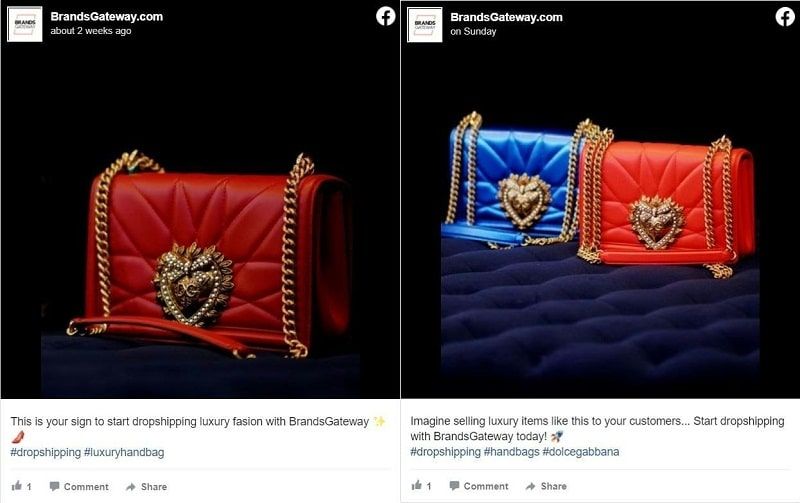
Cost-per-click (CPC)
In order to benefit from a successful fashion ad campaign, you need people to click on your ad and land on your website, and from there on, chances are high that they’ll start making purchases. However, this too will cost you money as you’ll be charged a fee every time your store receives a visit through an ad click. Nonetheless, Facebook supplies you with a metric that can assist you in managing these clicks and being on top of those expenses.
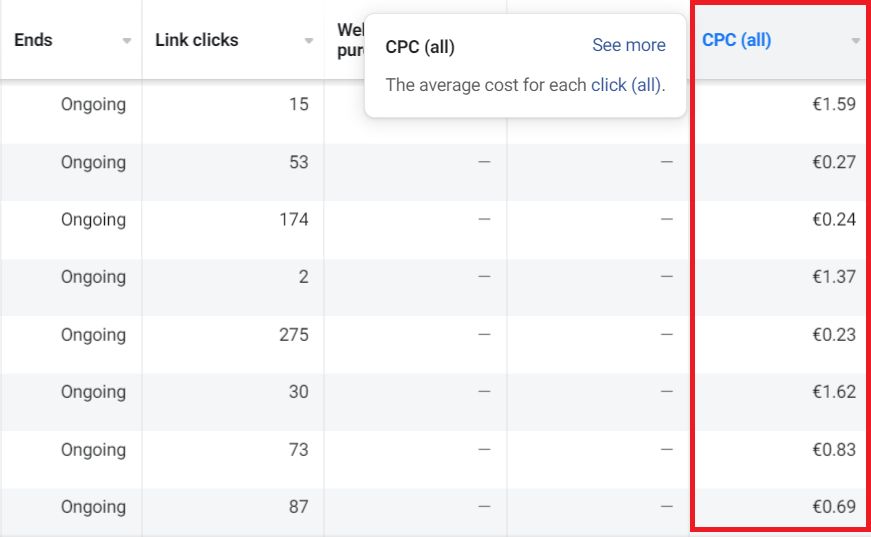
We’re talking about the cost-per-click metric, or for short CPC, which enables ad creators to review their ads’ efficiency and make the necessary adjustments if needed. The CPC is calculated by dividing the sum you’ve spent on your ad by the number of clicks you’ve received. The lower your CPC is, the higher your ROI (return on investment) is, meaning you’re paying less per click and your ad investment is paying off.
Cost-per-impression (CPM)
In addition to providing you with a budget-controlling metric and feature to calculate costs incurred by link clicks, the Ads Manager is also offering you the opportunity to measure your expenses based on the number of users that have come across your dropshipping store’s webpage. With the CPM metric or better known as cost per 1,000 impressions, you’re shown how much it costs you to display your ad per 1,000 internet users.
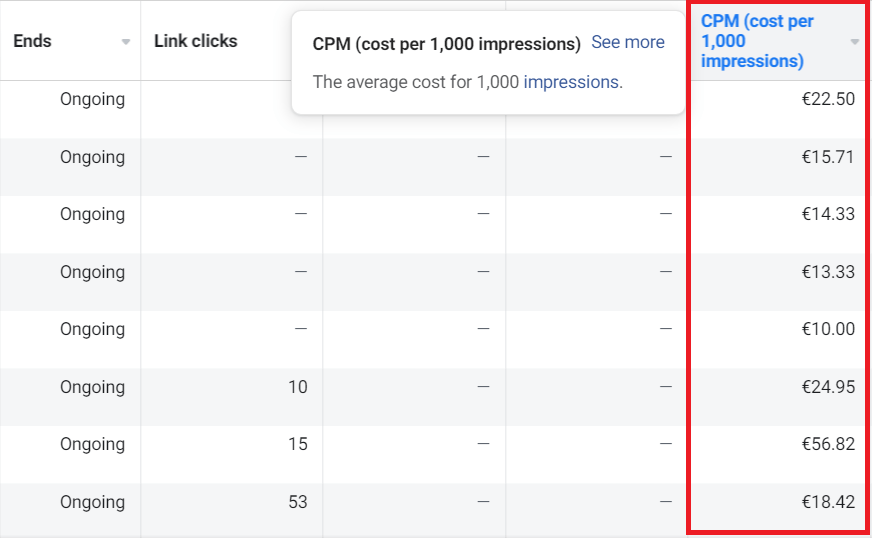
Keep in mind though, that in order to avoid paying high ad costs, you should try keeping your Facebook CPM as low as possible by implementing a variety of strategies, on top of our mind are:
- working on your visuals by using fashion photo editing apps;
- optimizing your target audience;
- keeping your ads relevant;
- testing them out regularly.
In that way, you’ll be able to keep your expenses at a minimum while still exposing your ad campaigns to a large internet audience.
Cost-per-result (CPR)
When starting the process of creating Facebook ads, the very first thing you’re asked is to choose your ad’s objectives. In other words, these are the goals you set for your ads and the message you’re trying to transmit through them. For example, if you’re trying to get your dropshipping store more exposure, the appropriate ad objective would be ‘brand awareness.’
If you’re aiming towards convincing people to take a certain action, such as registering to receive a fashion newsletter or buying an item, then you’re looking at the objective ‘conversions.’
The cost-per-result metric (CPR) specifies how successfully you’ve been in achieving your ad objective cost-wise. It displays the amount of money you’ve spent to accomplish that goal, how often you’ve reached the desired result, and if it has paid off. Dropshippers like yourself can use this metric to evaluate their ads’ productivity, which, consequently, leads to improving their website’s bounce rate and sales in general.
Conversion rate
The Facebook Ads Manager is so convenient to use that it even allows you to measure your clothing ad’s performance quite precisely through the conversion rate option – a metric that shows the percentage of people that your ad has converted into customers after clicking on it. That being the case, with this metric you’ll know instantaneously if your ad is doing its job and bringing you the desired amount of conversions, aka sales.
Bear in mind, nonetheless, that the conversions don’t only refer to purchases but other goals as well based on your chosen objective as already mentioned previously. Regardless of what your ads are trying to achieve, the conversion rate metric will always keep you posted on your ad’s success.
Frequency
One of the most efficient ways to expand your dropshipping clothing store’s customer base is by displaying ads to consumers in a recurrent manner. This method works wonders in:
- enhancing brand recognition;
- building up your store’s image;
- growing your customer base.
Nevertheless, you need to be careful here as too much exposure to your ads can, in fact, do more harm than good. If you opt for showing your ads too frequently to the same audience, chances are, with time, Facebook will display them to fewer and fewer people. This is where the Facebook ad frequency metric comes into play.
The ad frequency metric provides you with an average amount of times your ads have been seen by an individual, allowing you to keep a healthy balance when presenting the ads and staying away from unintentionally spamming your customers.
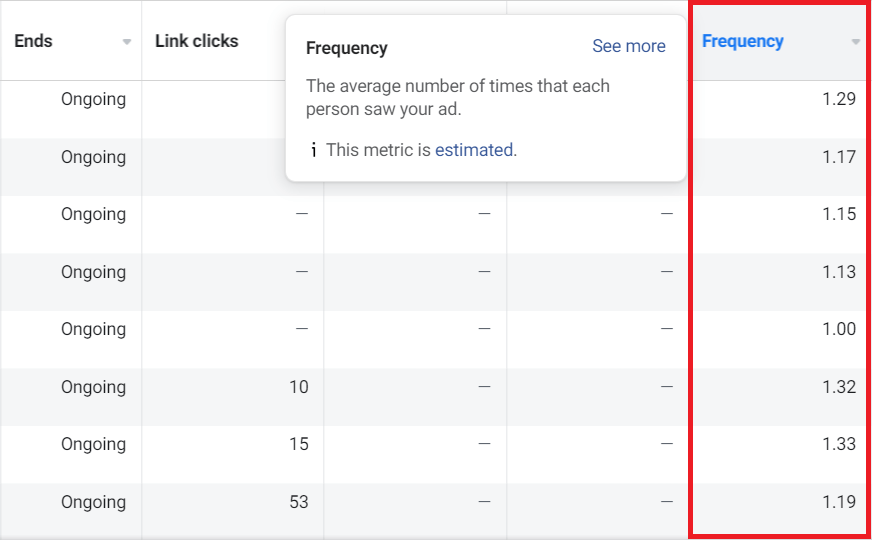
Relevance
Keeping your ads relevant to your goals is crucial in order to benefit from the positive outcomes Facebook advertisement brings to the table. A high relevance score doesn’t only showcase your ad to users more frequently but also allows you to save up on costs, such as the previously discussed CPC, CPM, and CPR-based expenses.
Luckily, the relevance metric offered by the Ads Manager enables you to keep an eye on your ad’s relevance, making certain your ad fulfills the objective set up at the beginning. One thing that will help bring back your ad on the right track in case of irrelevance is, for example, reviewing your ad keywords and relying for help on great keyword tools.
To illustrate, when you’re in the process of creating your fashion ad, ensure you’re using keywords that match the item you’re promoting, such as ‘designer shoes,’ or ‘luxury fashion’ but it’s as equally important for these to be similar to the queries your customers most often use when searching for that product.
With the Facebook relevance metric by your side, you’ll be constantly informed of where your ad stands and be able to implement the required modifications almost immediately. Take into account, however, that the relevance score is available for use once your ad has reached a minimum of 500 impressions.

Click-through rate (CTR)
Another key Facebook ad metric is the click-through rate measurement, informing you about the percentage of individuals who’ve clicked on your fashion ad. To put it another way, the click-through rate metric shows how many people have actually engaged with your ad and landed on your website out of those who’ve been exposed to it.
These are in fact received from your impressions, or otherwise known as people who’ve stumbled upon your ads. It’s ideal to strive for a high CTR, which indicates that internet users have found interesting enough what they’ve seen to make them click on the ad.
To give you a slight illustration, imagine your clothing ad has gathered 3,000 views, or impressions, out of which the Ads Manager has registered 1,500 clicks. When we divide the clicks by the views and multiply the number by 100, we get a CTR of 5%, alluding to the fact that your ad has been productive. By knowing these numbers at all times, you can quickly react, review your ad campaigns, and find out what may cause your ad to struggle in collecting the necessary clicks.
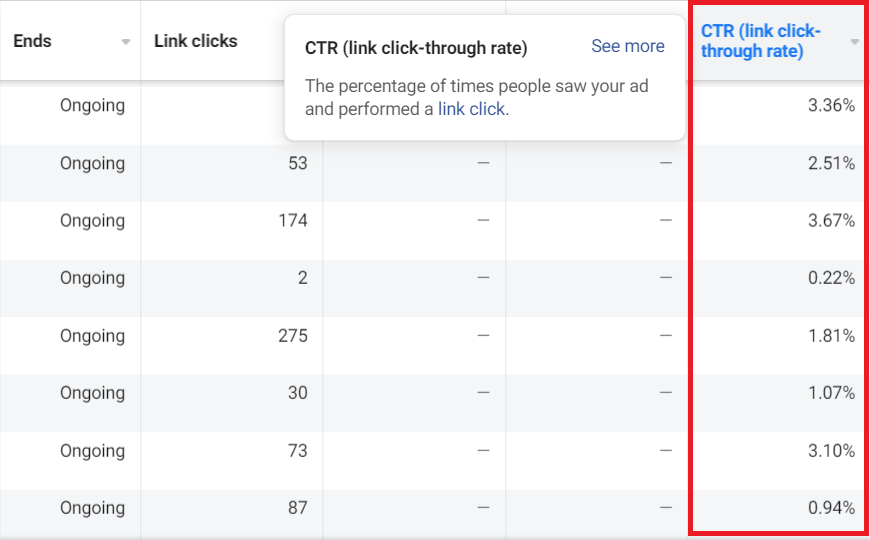
Link clicks
Link clicks is another metric closely related in function to the CTR metric, measuring once again the number of clicks received for your ad. Nevertheless, this time, you’re provided with click calculations regarding how many people have clicked on links that forward them to specific destinations, both outside and within the Facebook-based platforms.
For example, let’s say you started dropshipping designer sunglasses with BrandsGateway. Your ad can have multiple visual elements, such as ad image, description, headline, and CTA button, containing different links, all of which can redirect your potential customers to different destinations, whether it’s your store’s website, Facebook shop, and many others.
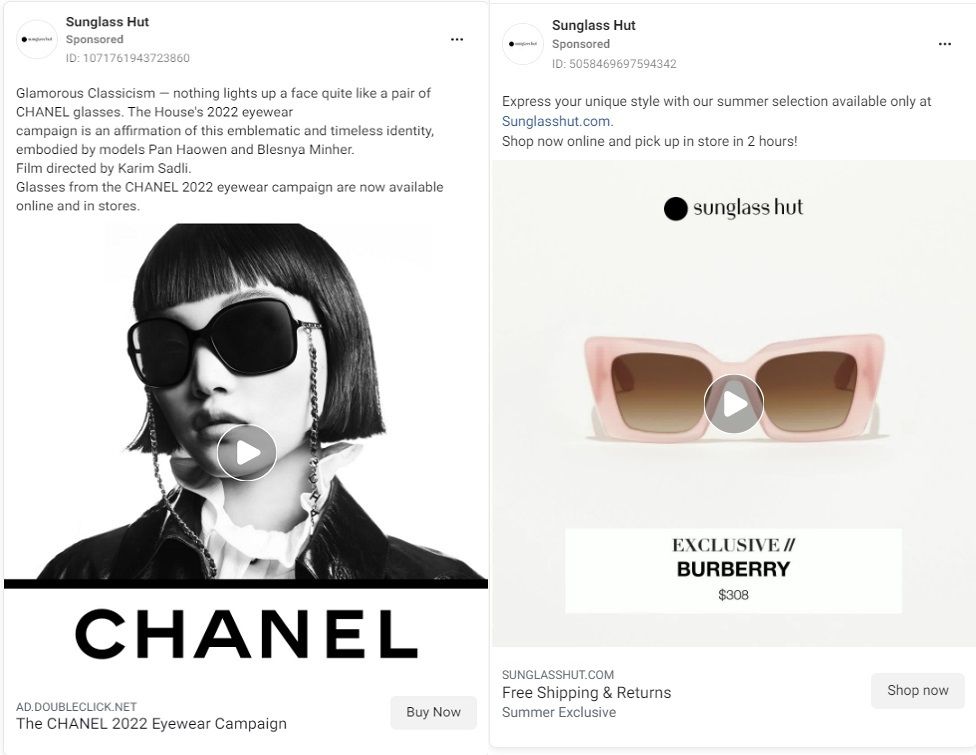
Outbound clicks
As opposed to link clicks, the outbound clicks metric calculates the number of clicks your ad has generated that have forwarded people to external destinations solely such as your webpage. By relying on this metric, you’re able to assess how much traffic your store’s site receives from your ads and the possibility to increase that number by stepping up your ad game if necessary.
Post engagement
Once you’ve published an ad, in order to know how successful it is, you need to keep a close eye on it by observing how people respond to it. The relevance score discussed above will offer you an overall view of how your ads are doing, but it won’t give you any specifics. The post engagement metric provides you with just that and much more. Therefore, it’s advised to use these two interchangeably in order to benefit from detailed reports regarding your ads’ performance.
The post engagement measurement gives you a full vision of all interactions made by people with your ad including:
- clicking a link;
- writing a comment;
- leaving a reaction;
- sharing the ad.
That being said, this metric shows you every action people take when they come across your ad, giving you the opportunity to measure your ad’s engagement in an accurate manner.
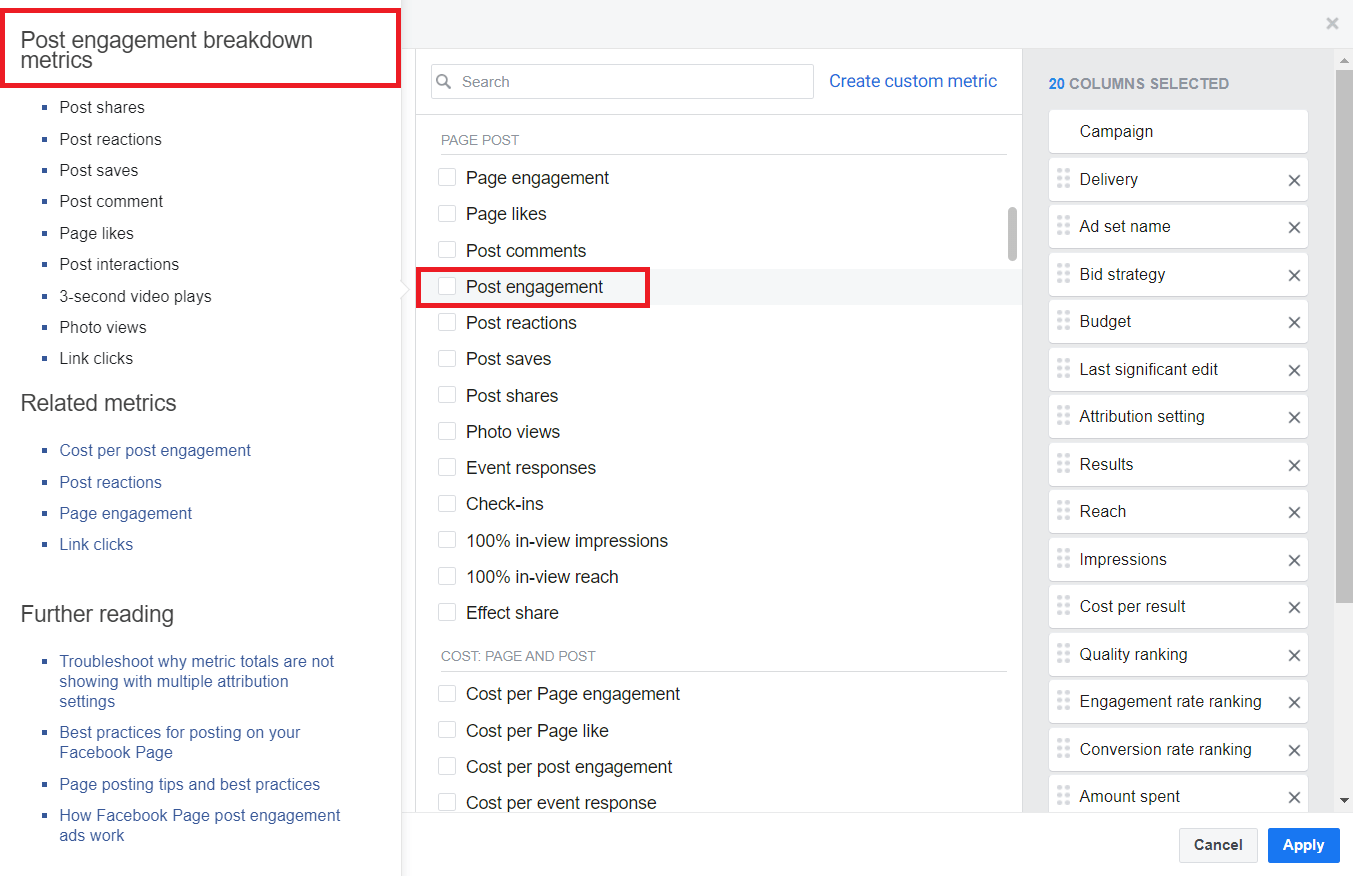
Return on Ad Spend (ROAS)
Facebook ads can bring many irresistible benefits to your dropshipping store – expanding your target audience, converting individuals into loyal consumers, improving your brand image, and establishing better engagement with customers, to name a few. At the end of the day, all of these lead to an increase in profitability.
Despite helping you enhance your dropshipping store’s sales, with the return on ad spend metric (ROAS), the Ads Manager is also enabling you to calculate the income you receive from purchases done as a result of your ads. That being the case, with ROAS, you can measure your revenues with incredible precision, thus knowing if your ad investment is actually worth your money.
To summarize everything up
The secret to creating a successful ad campaign is in creating a visually pleasing ad as well as taking into account the reports the Facebook ad metrics provide you with. Without them, despite how great your ad may look, there’s no other way to know if your customers are actually finding it interesting. The metrics analyzed above will help you in making sure your ads are staying productive and generating your desired results.
Related articles
Our clients' success stories speak volumes about the impact BrandsGateway has had on their businesses.
View More Articles








:format(webp)/https%3A%2F%2Fbrandsgateway.com%2Fapp%2Fuploads%2F2024%2F07%2FScreenshot_20240618_140550_Gallery.jpg)
:format(webp)/https%3A%2F%2Fprod-brandsgateway-images.s3.fr-par.scw.cloud%2F2022%2F03%2Fdropshipping-clothing-business-e3e613b8-0b1.jpg)
:format(webp)/https%3A%2F%2Fprod-brandsgateway-images.s3.fr-par.scw.cloud%2F2021%2F12%2Fdropshipping-clothing-france-e217776f-0aa.jpg)
:format(webp)/https%3A%2F%2Fbrandsgateway.com%2Fapp%2Fuploads%2F2024%2F07%2Ffind-products.png)
:format(webp)/https%3A%2F%2Fbrandsgateway.com%2Fapp%2Fuploads%2F2024%2F06%2Fdropshipping-tips.png)
:format(webp)/https%3A%2F%2Fprod-brandsgateway-images.s3.fr-par.scw.cloud%2F2023%2F09%2Fai-tools-dropshipping-f920f3cb-ee6.png)
:format(webp)/https%3A%2F%2Fprod-img.s3.fr-par.scw.cloud%2F2024%2F05%2Fsocial-media-chatgpt-76df2a03-6b3.png)
:format(webp)/https%3A%2F%2Fprod-img.s3.fr-par.scw.cloud%2F2024%2F04%2Fai-tools-social-media-576ef236-f5c.png)
:format(webp)/https%3A%2F%2Fprod-img.s3.fr-par.scw.cloud%2F2024%2F03%2Fcustomer-acquisition-9a87a244-f17.png)